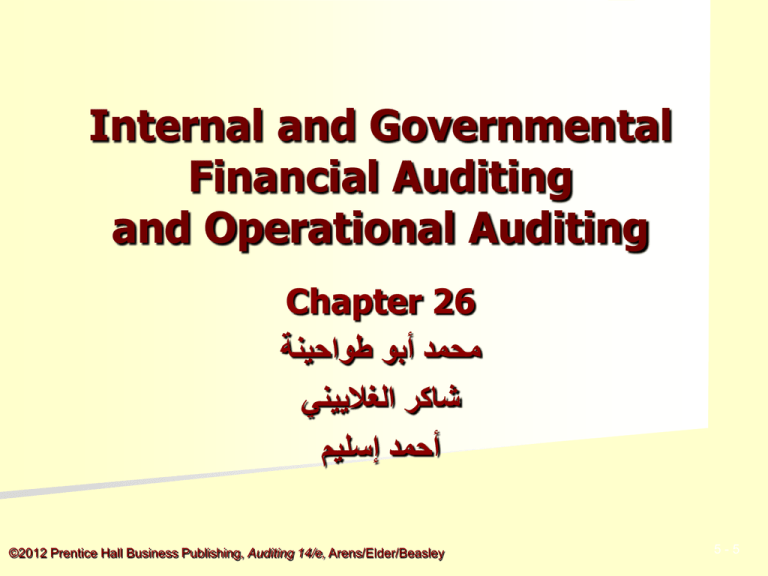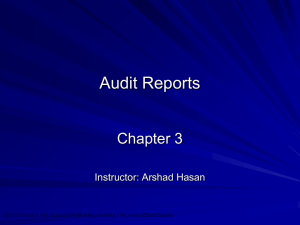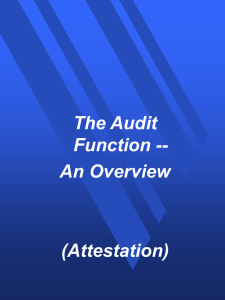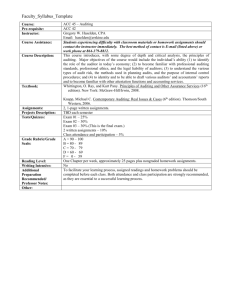Chapter 1 – The Demand for Audit and Other Assurance Services
advertisement

Internal and Governmental Financial Auditing and Operational Auditing Chapter 26 محمد أبو طواحينة شاكر الغالييني أحمد إسليم ©2012 Prentice Hall Business Publishing, Auditing 14/e, Arens/Elder/Beasley 5-5 Learning Objective 1 Explain the role of internal auditors in financial auditing. ©2012 Prentice Hall Business Publishing, Auditing 14/e, Arens/Elder/Beasley 26 - 2 Internal Auditing Internal auditing is an independent objective assurance and consulting activity designed to add value and improve an organization’s operations. Risk Management Controls Governance Processes ©2012 Prentice Hall Business Publishing, Auditing 14/e, Arens/Elder/Beasley 26 - 3 Internal Auditing Provide value through improved operational effectiveness while performing traditional responsibilities. Reviewing management information Safeguarding assets Ensuring compliance ©2012 Prentice Hall Business Publishing, Auditing 14/e, Arens/Elder/Beasley 26 - 4 Institute of Internal Auditors Ethical Principles Integrity Confidentiality Ethical Principles Competence Objectivity ©2012 Prentice Hall Business Publishing, Auditing 14/e, Arens/Elder/Beasley 26 - 5 Institute of Internal Auditors Rules of Conduct Integrity Confidentiality Rules of Conduct Competency Objectivity ©2012 Prentice Hall Business Publishing, Auditing 14/e, Arens/Elder/Beasley 26 - 6 Relationship of Internal and External Auditors The internal auditor is responsible to management The external auditor is responsible to financial statement users Both must be competent, objective, use a similar methodology, and consider risk and materiality ©2012 Prentice Hall Business Publishing, Auditing 14/e, Arens/Elder/Beasley 26 - 7 Learning Objective 2 Describe the auditing and reporting requirements under Government Auditing Standards and the Single Audit Act ©2012 Prentice Hall Business Publishing, Auditing 14/e, Arens/Elder/Beasley 26 - 8 Governmental Financial Auditing The primary source of authoritative literature for performance of government audits is Government Auditing Standards, which is issued by the GAO. Because of the color of the cover, it is usually referred to as the “Yellow Book.” ©2012 Prentice Hall Business Publishing, Auditing 14/e, Arens/Elder/Beasley 26 - 9 Governmental Financial Auditing The Yellow Book standards are often called generally accepted government auditing standards (GAGAS). ©2012 Prentice Hall Business Publishing, Auditing 14/e, Arens/Elder/Beasley 26 - 10 Financial Audit and Reporting Requirements – Yellow Book Financial Auditing Standards of the Yellow Book Consistent with GAAS/ Provide additional guidance… Materiality and significance Reporting ©2012 Prentice Hall Business Publishing, Auditing 14/e, Arens/Elder/Beasley Compliance auditing 26 - 11 Audit and Reporting – Single Audit Act and OMB Circular A-133 The threshold for requiring a single audit is $500,000. The Single Audit Act and OMB Circular A-133 contain requirements for the scope of the audit. Compliance with GAGAS Internal Control Risk ©2012 Prentice Hall Business Publishing, Auditing 14/e, Arens/Elder/Beasley Legal Compliance 26 - 12 Reporting Requirements An opinion on … Statements in accordance with GAAP Schedule of federal awards A report on … Internal controls Legal Compliance ©2012 Prentice Hall Business Publishing, Auditing 14/e, Arens/Elder/Beasley Findings and Questioned costs 26 - 13 Learning Objective 3 Distinguish operational auditing from financial auditing. ©2012 Prentice Hall Business Publishing, Auditing 14/e, Arens/Elder/Beasley 26 - 14 Operational Auditing The purpose of operational auditing is to determine the effectiveness or efficiency of any part of an organization Financial Auditing emphasizes whether historical information was correctly recorded while operational auditing emphasizes effectiveness and efficiency ©2012 Prentice Hall Business Publishing, Auditing 14/e, Arens/Elder/Beasley 26 - 15 Learning Objective 4 Provide an overview of operational audits. ©2012 Prentice Hall Business Publishing, Auditing 14/e, Arens/Elder/Beasley 26 - 16 Effectiveness Versus Efficiency Effectiveness refers to accomplishing objectives Efficiency is defined as reducing cost without reducing effectiveness ©2012 Prentice Hall Business Publishing, Auditing 14/e, Arens/Elder/Beasley 26 - 17 Effectiveness Versus Efficiency Inefficiency Example Acquisition of goods and services is too costly Bids for purchases of materials are not required Raw materials are not available when needed An assembly line was shut down for lack of materials A duplication of effort by employees exists Production and accounting keep identical records ©2012 Prentice Hall Business Publishing, Auditing 14/e, Arens/Elder/Beasley 26 - 18 Effectiveness Versus Efficiency Inefficiency Example Work is done that serves no purpose Vendors’ invoices and receiving reports are filed without being used There are too many employees Office work could be done with one less assistant ©2012 Prentice Hall Business Publishing, Auditing 14/e, Arens/Elder/Beasley 26 - 19 Relationship Between Operational Auditing and Internal Controls Reliability of financial reporting Efficiency and effectiveness of operations Compliance with applicable laws and regulations ©2012 Prentice Hall Business Publishing, Auditing 14/e, Arens/Elder/Beasley 26 - 20 Types of Operational Audits Functional Organizational Special assignments ©2012 Prentice Hall Business Publishing, Auditing 14/e, Arens/Elder/Beasley 26 - 21 Who Performs Operational Audits Internal auditors Government auditors CPA firms ©2012 Prentice Hall Business Publishing, Auditing 14/e, Arens/Elder/Beasley 26 - 22 Independence and Competence of Operational Auditors The two most important qualities for an operational auditor Competence Independence ©2012 Prentice Hall Business Publishing, Auditing 14/e, Arens/Elder/Beasley 26 - 23 Learning Objective 5 Plan and perform an operational audit. ©2012 Prentice Hall Business Publishing, Auditing 14/e, Arens/Elder/Beasley 26 - 24 Specific Criteria More specific criteria are usually desirable before starting an operational audit Sources of criteria include: Historical performance Benchmarking Engineered standards Discussion and agreement ©2012 Prentice Hall Business Publishing, Auditing 14/e, Arens/Elder/Beasley 26 - 25 Phases in Operational Auditing Planning Staffing Scope Controls Evidence gathering and evaluation Eight types Documentation ©2012 Prentice Hall Business Publishing, Auditing 14/e, Arens/Elder/Beasley Reporting and follow-up Scope Findings Recommendations 26 - 26 End of Chapter 26 ©2012 Prentice Hall Business Publishing, Auditing 14/e, Arens/Elder/Beasley 5-5



